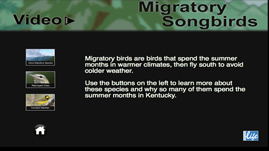Teachers' Domain - Digital Media for the Classroom and Professional Development
User: Preview


Some species of birds are not physically adapted to the extreme shifts in temperature from one season to the next. These species spend the summer in one geographic location and migrate to another region with milder weather in the winter months. Adapted from the Kentucky Life Biodiversity series, this video interactive looks at examples of migratory birds found in the Natural Bridge area and the efforts made to record their migratory patterns.
It's all about survival. Birds, fish, and animals may live in very different habitats in very different regions, but they all share one common factor. They are all looking for the best situation in which to live, breed, and raise their young. In this way, they ensure their survival as well as the survival of their individual species.
Some whales have been known to swim thousands of miles to breed. Herds of other animal species cross large areas to find a better supply of food during certain months of the year. And some species of birds fly thousands of miles to find a warmer climate for the cold winter months. They do this because they are notphysically adapted to endure extreme weather conditions and migrating, or moving, to another location offers the best chance for them to survive.
We know about these patterns of migration because researchers have studied them for years. They have tracked the migration patterns in different species and learned more about where they go and why they make the trip.
Each year, researchers at Natural Bridge State Park in Central Kentucky record the return of bird species that make their summer home in the park. This information is used to help determine the health of the area's inhabitants. If Natural Bridge is a desirable location for migrating birds, it means they can find the food and habitat they need to survive there. And that is good news in terms of the region remaining an area of significant biodiversity.
About Migratory Species
Here at Natural Bridge, and in this area, we have, I guess, probably twenty, thirty different species that will fly all the way down to Central America and back every single year. When you see, you know, species coming back year after year to these sites it really it really tells you how important there are because there are not many of these sites left in our state.
A lot of these birds really need intact large tracks of forested area to survive. They’re not necessarily what we considered endangered, but many of them are declining species. We estimate some of our our forest birds might be 25% might have a 25% decline over the past 40 to 50 years. So, they’re not doing that great and it is mainly because of habitat loss. So areas like this, and any place where we have thousands of intact forested acres are really, really important.
Red-Eyed Vireo
This is a Red-Eyed Vireo, and they’re relatively common in mature woodlands throughout Kentucky, but they do need forested tracks, pretty big, forested areas. They breed here in this area, in Kentucky along the Red River Gorge area, like I said, in a lot of forested areas. And uh he is another sign that you have a pretty healthy forest component. He is an upper-canopy bird. You hear him a lot more than you see him. (bird noises)
Funniest things about these birds I’ve worked with throughout these years is uh the same birds in the same species tend to act kind of similar. Vireos tend to be kind of ornery and do a lot of biting and don’t like being messed with.
Hooded Warbler
This is a Hooded Warbler. We have uh a bunch of different kinds of warblers in Kentucky. This is one that is pretty common in the Natural Bridge area, Red River Gorge area, you can find him on the Kentucky river, different places throughout the state. They kind of like brushy areas, rhododendron thickets. That is why they like it around here so much. They are really pretty.
 Loading Standards
Loading Standards